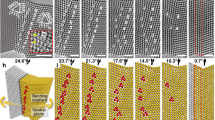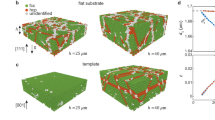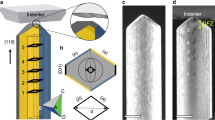Abstract
Dislocations1 are line defects that bound plastically deformed regions in crystalline solids. Dislocations terminating on the surface of materials can strongly influence nanostructural and interfacial stability, mechanical properties, chemical reactions, transport phenomena, and other surface processes. While most theoretical and experimental studies have focused on dislocation motion in bulk solids under applied stress2,3 and step formation due to dislocations at surfaces during crystal growth4,5,6,7, very little is known about the effects of dislocations on surface dynamics and morphological evolution. Here we investigate the near-equilibrium dynamics of surface-terminated dislocations using low-energy electron microscopy8. We observe, in real time, the thermally driven nucleation and shape-preserving growth of spiral steps rotating at constant temperature-dependent angular velocities around cores of dislocations terminating on the (111) surface of TiN in the absence of applied external stress or net mass change. We attribute this phenomenon to point-defect migration from the bulk to the surface along dislocation lines. Our results demonstrate that dislocation-mediated surface roughening can occur even in the absence of deposition or evaporation, and provide fundamental insights into mechanisms controlling nanostructural stability.
This is a preview of subscription content, access via your institution
Access options
Subscribe to this journal
Receive 51 print issues and online access
$199.00 per year
only $3.90 per issue
Buy this article
- Purchase on Springer Link
- Instant access to full article PDF
Prices may be subject to local taxes which are calculated during checkout



Similar content being viewed by others
References
Cottrell, A. H. in Dislocations and Plastic Flow in Crystals (eds Fowler, R. H., Kapitza, P., Mott, N. F. & Bullard, E. C.) Ch. 1 (Oxford Univ. Press, London, 1953)
Bulatov, V., Abraham, F. F., Kubin, L., Devincre, B. & Yip, S. Connecting atomistic and mesoscale simulations of crystal plasticity. Nature 391, 669–672 (1998)
Lagow, B. W. et al. Observation of dislocation dynamics in the electron microscope. Mater. Sci. Eng. A 309–310, 445–450 (2001)
Verma, A. R. & Amelinckx, S. Spiral growth on carborundum crystal faces. Nature 167, 939–940 (1951)
Teng, H. H., Dove, P. M., Orme, C. A. & De Yoreo, J. J. Thermodynamics of calcite growth: Baseline for understanding biomineral formation. Science 282, 724–727 (1998)
Pina, C. M., Becker, U., Risthaus, P., Bosbach, D. & Putnis, A. Molecular-scale mechanisms of crystal growth in barite. Nature 395, 483–486 (1998)
Burton, W. K., Cabrera, N. & Frank, F. C. The growth of crystals and the equilibrium structure of their surfaces. Phil. Trans. R. Soc. Lond. A 243, 299–358 (1951)
Bauer, E. Low-energy electron microscopy. Rep. Prog. Phys. 57, 895–938 (1994)
Tromp, R. M. & Reuter, M. C. Design of a new photo-emission/low-energy electron microscope for surface studies. Ultramicroscopy 36, 99–106 (1991)
Kodambaka, S. et al. Absolute TiN(111) step energies from analysis of anisotropic island shape fluctuations. Phys. Rev. Lett. 88, 146101 (2002)
Zinke-Allmang, M., Feldman, L. C. & Grabow, M. H. Clustering on surfaces. Surf. Sci. Rep. 16, 377–463 (1992)
Frank, F. C. & Read, W. T. Multiplication processes for slow moving dislocations. Phys. Rev. 79, 722–723 (1950)
Bardeen, J. & Herring, C. in Imperfections in Nearly Perfect Crystals (eds Shockley, W., Hollomon, J. H., Maurer, R. & Seitz, F.) Chap. 10 (Wiley, New York, 1952)
Hull, D. & Bacon, D. J. Introduction to Dislocations Ch. 8 (Pergamon, Oxford, 1984)
Kodambaka, S. et al. Size-dependent detachment-limited decay kinetics of two-dimensional TiN islands on TiN(111). Phys. Rev. Lett. 89, 176102 (2002)
Sundgren, J. E., Johansson, B. O., Rockett, A., Barnett, S. A. & Greene, J. E. in Physics and Chemistry of Protective Coatings (eds Greene, J. E., Sproul, W. D. & Thornton, J. A.) 95–115 (American Institute of Physics, New York, 1986)
Gall, D., Kodambaka, S., Wall, M. A., Petrov, I. & Greene, J. E. Pathways of atomistic processes on TiN(001) and (111) surfaces during film growth: an ab initio study. J. Appl. Phys. 93, 9086–9094 (2003)
Weertman, J. & Weertman, J. R. in Elementary Dislocation Theory (eds M. E., Weertman, J. & Weertman, J. R.) Ch. 6 (Macmillan, New York, 1964)
Justo, J. F., de Koning, M., Cai, W. & Bulatov, V. V. Point defect interaction with dislocations in silicon. Mater. Sci. Eng. A 309–310, 129–132 (2001)
Indenbom, V. L. & Saralidze, Z. K. in Elastic Strain Fields and Dislocation Mobility (eds Indenbom, V. L. & Lothe, J.) Ch. 10 (Elsevier Science, Amsterdam, 1992)
McCarty, K. F., Nobel, J. A. & Bartelt, N. C. Vacancies in solids and the stability of surface morphology. Nature 412, 622–625 (2001)
Giesen, M. Step and island dynamics at solid/vacuum and solid/liquid interfaces. Prog. Surf. Sci. 68, 1–153 (2001)
Acknowledgements
This work was supported by the US Department of Energy (DOE), Division of Materials Science, through the University of Illinois Frederick Seitz Materials Research Laboratory (FS-MRL). We thank C. P. Flynn, H. Birnbaum, R. J. Pflueger and P. O. Å. Persson for discussions and critical reading of the manuscript. We also appreciate the use of the facilities in the Center for Microanalysis of Materials, partially supported by DOE, at the FS-MRL.
Author information
Authors and Affiliations
Corresponding author
Ethics declarations
Competing interests
The authors declare that they have no competing financial interests.
Rights and permissions
About this article
Cite this article
Kodambaka, S., Khare, S., Święch, W. et al. Dislocation-driven surface dynamics on solids. Nature 429, 49–52 (2004). https://doi.org/10.1038/nature02495
Received:
Accepted:
Issue Date:
DOI: https://doi.org/10.1038/nature02495
Comments
By submitting a comment you agree to abide by our Terms and Community Guidelines. If you find something abusive or that does not comply with our terms or guidelines please flag it as inappropriate.



